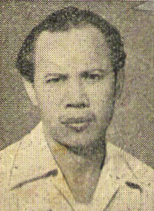
Muhammad Hatta Lukman was an Indonesian communist politician, who served as the First Deputy Chairman of the Central Committee of the Communist Party of Indonesia (PKI), and a member of the People's Representative Council from 1956 until 1959. He was executed following the 1965 crackdown on the PKI.

The Digul River is a major river in southern Papua province, Indonesia, on the island of New Guinea. It is the fourth longest river in New Guinea after Sepik River, Mamberamo River and Fly River. With a total length of 853 km (530 mi) and has a drainage basin of 45,900 km2 (17,700 sq mi).
Tanah Merah is a town in South Papua province of Indonesia on the bank of Digul river, located some two hundred miles from Merauke within the interior of Western New Guinea. It is the administrative center of Boven Digoel Regency; administratively, it is covered by Persatuan kampung of Mandobo District.
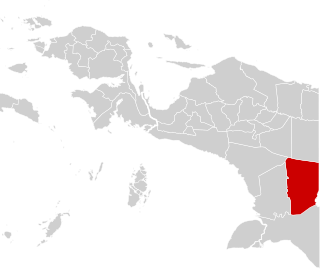
Boven Digoel Regency is an inland regency (kabupaten) in the northeastern part of the Indonesian province of South Papua. It was split off from Merauke Regency on 12 November 2002. The regency covers an area of 27,108.29 km2 (10,466.57 sq mi), and the total population was 55,784 at the 2010 Census and 64,285 at the 2020 Census; the official estimate as at mid 2022 was 65,193. The administrative centre is the town of Tanah Merah in Mandobo District.
Kwee Tek Hoay was a Chinese Indonesian Malay-language writer of novels and drama, and a journalist.

Boenga Roos dari Tjikembang is a 1927 vernacular Malay-language novel written by Kwee Tek Hoay. The seventeen-chapter book follows a plantation manager, Aij Tjeng, who must leave his beloved njai (concubine) Marsiti so that he can be married. Eighteen years later, after Aij Tjeng's daughter Lily dies, her fiancé Bian Koen discovers that Marsiti had a daughter with Aij Tjeng, Roosminah, who greatly resembles Lily. In the end Bian Koen and Roosminah are married.
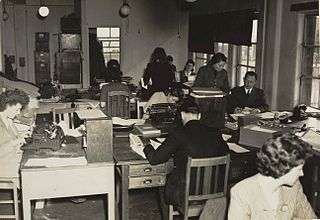
The Netherlands Indies Government Information Service (NIGIS) was a civil secret service and propaganda organisation based in Australia, during and after World War II. NIGIS was affiliated with the Netherlands East Indies Forces Intelligence Service (NEFIS) and the Netherlands Indies Civil Administration (NICA).

Liem Koen Hian was an Indonesian journalist and politician. He was born in Banjarmasin, the son of a local peranakan Chinese business owner, Liem Ke An. He attended the Hollands-Chineesche School to class 6, when he was reportedly expelled after coming into conflict with a Dutch teacher. He subsequently worked as a business clerk for Royal Dutch Shell in Balikpapan before returning to Banjarmasin to work for a local newspaper. The name of the newspaper is not known, but may have been Penimbangan, Pengharepan, or Borneo Post.

Neratja, later Hindia Baroe, was a Malay language newspaper printed from 1917 to 1926 in Weltevreden, Dutch East Indies. Although originally founded with government support to be a Malay voice for the Dutch Ethical Policy, before long it became associated with the Sarekat Islam and the Indonesian National Awakening. Among its editors were important figures of the Indonesian national movement such as Abdul Muis and Agus Salim.

Lie Eng Hok (1893-1961) was an Indonesian independence activist and Indonesian Communist Party (PKI) supporter in the Dutch East Indies. He was also a journalist for the popular Chinese Indonesian newspaper Sin Po. The Dutch government accused him of being involved in the 1926 Banten rebellion and exiled him to the Boven-Digoel concentration camp from 1927 to 1932. He was a personal friend of Wage Rudolf Supratman, author of the Indonesian national anthem. He was granted the status of Pioneer of Independence by the Indonesian government in 1959.

Aliarcham (c.1901-1933) was a Sarekat Islam and Indonesian Communist Party party leader, activist and theoretician in the Dutch East Indies. He was a major figure behind the PKI's turn to more radical policies in the mid-1920s. He was arrested by Dutch authorities in 1925 and exiled to the Boven-Digoel concentration camp, where he died in 1933. He became a well-known Martyr, especially among Communists and Indonesian nationalists.
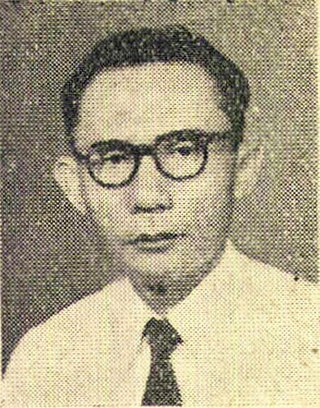
Osa Maliki Wangsadinata was an Indonesian politician who served as the chairman of the Indonesian National Party (PNI) and a deputy speaker of the People's Consultative Assembly (MPR) from 1966 until his death. Born in Padalarang, Osa was educated at a Taman Siswa school. He participated in an unsuccessful communist rebellion against the colonial government in 1926, being exiled to the Boven-Digoel concentration camp as a result. After returning from exile in 1938, he worked as a teacher. During the Japanese occupation, Osa worked in the propaganda section of a Hōkōkai and became a member of the Suishintai, however, he was briefly detained by the Kenpeitai over his connections to an underground resistance movement.
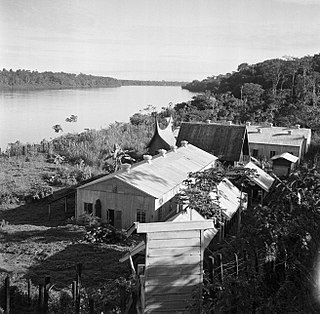
Jodensavanne was a Dutch internment camp for political prisoners from the Dutch East Indies operated in Surinam during World War II. The camp was named after a nearby, long-abandoned Jewish colony, Jodensavanne.
Soetitah was a Sarekat Islam and Communist Party of Indonesia (PKI) propagandist, activist, and schoolteacher in Semarang, Dutch East Indies in the 1910s and 1920s. She was a close ally of Semaun, Tan Malaka, and other Semarang communists of the time and was chair of the women's section of the party in the early 1920s. She was exiled by the Dutch to the Boven-Digoel concentration camp from 1927 to 1930.

Louis Johan Alexander Schoonheyt (1903-1986), commonly known as L. J. A. Schoonheyt, was a Dutch medical doctor, writer, and supporter of the National Socialist Movement in the Netherlands before World War II. From 1935 to 1936 he was the camp doctor at the Boven-Digoel concentration camp in New Guinea, Dutch East Indies, and is mostly known today for the book he wrote about his experiences there, Boven-Digoel: Het land van communisten en kannibalen (1936). His praise for the conditions in the camp earned him the ire of the internees, Indonesian nationalists, and Dutch human rights advocates; E. du Perron called him a 'colonial bandit', while many internees burned his book after reading it in the camp.
Moenasiah was a Sarekat Islam and Indonesian Communist Party leader active in Semarang, Central Java, Dutch East Indies during the 1920s. She was chairperson of the women's section of the Communist Party for a time in the 1920s. She was exiled by Dutch authorities to Boven-Digoel concentration camp from 1927 to 1930.

Soekaesih was a Communist Party of Indonesia activist known for being one of only a handful of female political prisoners exiled by the Netherlands government to Boven-Digoel concentration camp. After being released she traveled to the Netherlands in the late 1930s and campaigned for the camp to be shut down.

Siem Piet Nio, who wrote under the pen name Hong Le Hoa, was an Indonesian language writer, magazine editor, journalist and Women's rights advocate from the Dutch East Indies who was active during the 1920s and 1930s.

Njonja Tjoa Hin Hoei, who was born Kwee Yat Nio and was also known by the Buddhist name Visakha Gunadharma, was a Chinese Indonesian journalist, writer, Buddhist figure, and political activist during the late colonial and early independence periods. She was especially known for being publisher and editor of a women's magazine Maandblad Istri which ran from the 1930s to the early 1950s.

Abdoe'lxarim M. S., who was born Abdoel Karim bin Moehamad Soetan, was a journalist and Communist Party of Indonesia leader. He was interned in Boven-Digoel concentration camp from 1927 to 1932. During World War II, he collaborated with the Japanese and became an important figure in recruiting support for them in Sumatra; after their defeat he then became a key figure in the anti-Dutch republican forces during the Indonesian National Revolution.


















